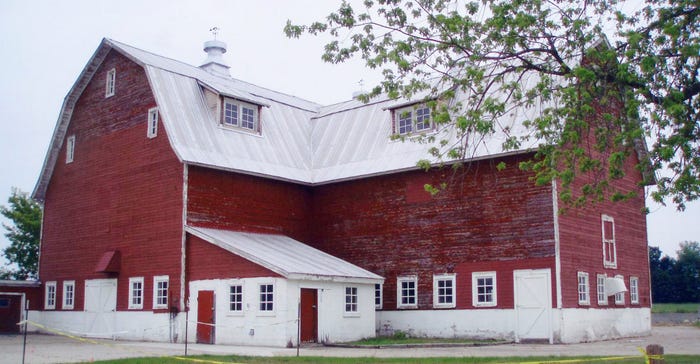December 17, 2018

Barns have a way of teaching, especially when what we learn was not at all what we expected. Such is the case with the barn at Eastmanville Farm County Park, 7851 Leonard St., Coopersville.
The park, situated on 229 acres, was once the Ottawa County Poor Farm. Poor farms or poor houses replicated a practice, which began in England, to provide shelter and work for people so poor, handicapped or ill that they could not take care of themselves.
Mandated by an 1830 law, which required every county to establish a poor house or a poor farm, they were scattered across Michigan and many other states into the 1900s. They were imposing in their construction and fearsome in their function, at least to some. The reputation of county poor farms depended largely on the people entrusted to run them, both onsite and at the governmental level. Stories abound of what life was like and often, history is not kind.
How many poor farms once existed in Michigan and how many still exist with at least some of their buildings converted to new purposes is not known. Many of the stately barns and outbuildings are gone. One notable exception is the barn at Eastmanville Farm County Park, and it was in learning about the barn that assumptions were changed.
“The label ‘poor farm’ is a misnomer,” says Marjorie Viveen, volunteer historian for Ottawa County Parks. “A review of Ottawa County poor farm death certificates on which occupations were posted, revealed teachers, policemen, farmers and a veterinarian. Not all poor farm residents were poor. In fact, in Ottawa County about 30% paid their own keep. It was a time without Social Security, and without caretakers within one’s family, the poor farm was a viable option.”
Viveen’s research has revealed that residents included a Civil War veteran, a man who fought in both the War of 1812 and the Civil War, a coast guardsman, an African-American man from Grand Haven who was a representative to the Civil Rights Convention, and even a county judge.
Poor farms, usually run by a husband-wife team, included barns where residents who were able (often called inmates), helped provide for their own care by tending livestock.
According to an article from the Grand Rapids News (Garret Ellison, 2016), the Eastmanville site began with a farmhouse once belonging to the Daniel Realy family on their 1830s wheat farm. The house was later an inn for travelers before the poor farm opened in 1866 and finally it was a laundry.
Another residence was built in 1886, and after it was closed in 1978, plans for a new, modern facility were eventually developed and a $1.25 million single-story structure, named “Community Haven,” was dedicated in August 1978.
The facility continued to operate as a farm until 2000, with residents doing a variety of chores, including caring for animals, and making bread, jam and other farm products.
“The plank-frame barn was built in 1928 to replace the original lost to a fire. It is likely patterned after plans sold by the James Manufacturing Co., makers of Jamesway farm equipment,” says Jessica VanGinhoven, communications specialist for the Farm Park. “Its main section is 38 feet tall, gambrel-style, steel-roofed, 80 feet in length, and it has a 52-foot T-section, for a total of 10,000 square feet.”
In its heyday, 60 cattle were milked in the barn, which still holds the stanchions, gutter-cleaning system and hay track. The main portion of the barn has a 4-foot poured concrete wall foundation, while the smaller section has an 8-foot block wall. Making the barn especially striking are its six double-window dormers and three ventilators.
A 16-by-18-foot milk house, built in the 1950s, is adjoined to the southwest corner of the barn to store milk away from animals in cleaner, cooler conditions, a legal requirement that improved milk safety.
Between the silo and the barn is a 12-by-22-foot silo room with a gable roof. Other buildings include a machine shed from the 1970s and a block silo. No residential structures remain. A cemetery for residents who completed their lives there is also on the grounds.
The barn stood vacant for several years, which often spells the beginning of the end for many. The property was opened to the public as a county park in 2005. Repairs to the barn in 2009 included cabling and bracing to straighten the structure, window and siding repairs, and painting.
“We have identified additional work to be done this year,” says VanGinhoven, “and our parks commission has made a commitment to do it before problems get worse. It’s worth the investment. The building has historical significance, and people from this community love the barn. It’s in the background of many, many family photos.”
Scheduled improvements include bracing, replacement of damaged framing, and roof work to stop leaking around the dormers and ventilators.
In 2016, a sesquicentennial event was held at the farm to pay tribute to its history. Displays set up in the barn shared images, artifacts and stories of the farm’s history.
The barn is used for storage, but planning is underway to determine its long-term function.
The park features hiking, equestrian trails and picnic areas. The West Michigan Agricultural Education Center leases some 80 acres of the property for demonstration purposes.
Eastmanville Farm County Park is open year-round.
Arnett writes from Battle Creek.
About the Author(s)
You May Also Like




